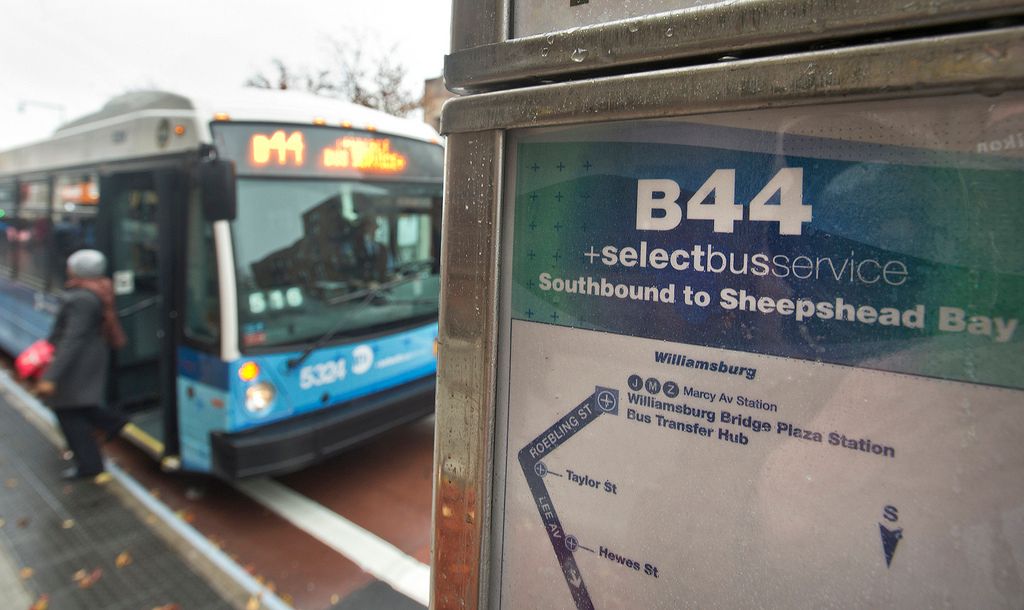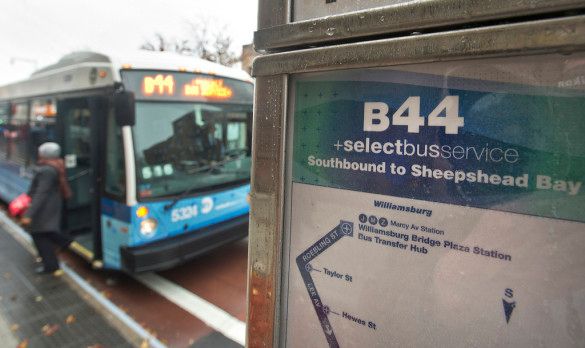The Commute: We Now Have Definitive Proof Select Bus Service (SBS) Is A Failure — Part 2 Of 2


THE COMMUTE: Yesterday, we looked at SBS routes in the Bronx, Manhattan and Staten Island. Today we examine the B44 SBS in Brooklyn and future routes.
Brooklyn
Annual ridership on the B44 is down by 4.4 percent as compared to the borough’s local bus average of 1.6 percent. The B49, which shares the same route as the B44 SBS northbound along Rogers Avenue, had a greater ridership loss of 6.8percent. So even with B49 riders shifting to the B44 SBS, the route still suffered a ridership loss almost three times the borough average.
Since we do not have any readily available statistics for taxi cabs and vans, we do not know how many riders shifted to those modes, but it is probably a significant number, since New York Avenue riders were significantly impacted with increased walking distances to Rogers Avenue and increased waiting times if they chose not to walk or take an extra bus. The only other north/south route is the B46 bus, which runs along Utica Avenue and is also far away. It also lost riders greater than the borough average.
The B44 did not attract huge passenger shifts from routes that connect with the Brighton line as the MTA predicted when it made its presentation to CB 13 back in 2010. At that time, I warned them that it would just not happen. The SBS may also have increased traffic congestion. In 2010, it was suggested that the route be extended to Kingsborough Community College. This would have greatly increased patronage from under six passengers per bus during the peak hours, which the MTA immediately dismissed. Better planning through altering other local bus routes, as I previously suggested, could have made the difference between success and failure.
What Does All This Mean?
Two of the seven SBS routes, both in the Bronx, may be a success, but we still do not have enough data to say for sure. However, three routes — the M15, M34, and B44 — are definite failures. The M60 and S79 appear to have made little difference using ridership as the metric.
M86 SBS
Ridership on the proposed M86 SBS will most likely decline. That will happen because most riders on Manhattan’s crosstown bus routes have the option of walking when transferring from the subway. Longer buses will mean fewer of them and longer waits, although bus travel time will be speeded up through paying your fare before you board. The bus may save 10 minutes from river to river. However, most passengers who make short trips will only save about three minutes.
Taking into account the chance of missing a bus by having to pre-pay your fare, you will lose more than three minutes by having to wait for the next bus. When that happens, most will choose to walk. Since the MTA will not lose revenue from passengers who will no longer transfer from the subway, the MTA will not care about them. In short, SBS on the M86 makes good business sense for the MTA: fewer buses and a cost savings with little or no effect on revenue. It will mean, for the passenger, longer waits, possibly a savings of three minutes, and walking more often.
B46 SBS
I predict that the B46 will also suffer from enforcement problems, as the B44 does, particularly between Tilden Avenue and Clarendon Road where double parking is rampant. By enforcement problems I mean by drivers who intentionally block bus lanes causing traffic congestion and do not receive summonses, as well as those who innocently receive summonses because of poor signage. It will also suffer from increased traffic congestion.
Conclusion
In this week’s Rockaway Times, I proposed an alternate to SBS, which would save buses just as much time and would be effective on all bus routes, not only 10 percent of them. I also gave my opinions to Greg Mocker of New York’s PIX11 on the proposed Woodhaven Bus Rapid Transit (BRT). At the conclusion of the interview, a gentleman approached Mocker and explained that he had just received a photo summons by mail because he crossed a bus lane while pulling out of a parking space. That is not the way the enforcement is supposed to work. Neither should you be receiving summonses three months late. Nor should fare machines be broken for two weeks with riders receiving summonses for riding the bus when the machines are out of service. Initial confusion and worn out bus lanes are also preventable and you shouldn’t have to fight for additional SBS bus stops that are needed in the first place, here and here.
View the MTA or DOT websites and you will learn nothing about these problems like they do not exist. All you will see are figures, such as that 95 percent of SBS riders are satisfied, bus speeds are 25 percent quicker, and ridership is increasing on SBS routes. Just a bunch of lies. We need a moratorium on future SBS bus routes.
The Commute is a weekly feature highlighting news and information about the city’s mass transit system and transportation infrastructure. It is written by Allan Rosen, a Manhattan Beach resident and former Director of MTA/NYC Transit Bus Planning (1981).
Disclaimer: The above is an opinion column and may not represent the thoughts or position of Sheepshead Bites. Based upon their expertise in their respective fields, our columnists are responsible for fact-checking their own work. Their submissions are edited only for length, grammar and clarity. If you would like to submit an opinion piece or become a regularly featured contributor, please e-mail nberke [at]sheepsheadbites [dot]com.